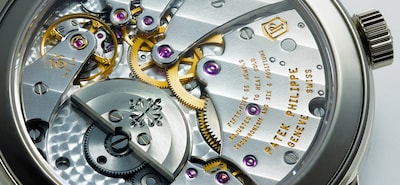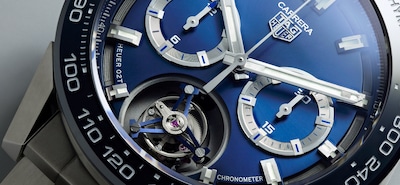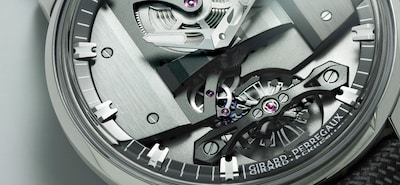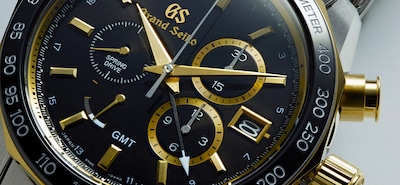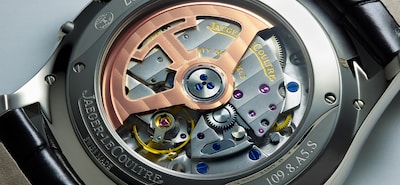Beating Heart : Inside A Timepiece
By Alex Doak | 6 minute read
In a world full of smart-tech and connected devices, the Swiss, German, Japanese and British watchmakers have not only preserved their craft in luxurious guise, but reignited their historic urge for innovation. Watch writer and expert Alex Doak dons a loupe and dives into the spellbinding minutiae of today's cleverest watchmaking
PATEK PHILIPPE IN-LINE PERPETUAL CALENDAR REF. 5236P
Until 29 February 2100, when the infallibility of the Gregorian calendar nips us on the proverbial, the so-called perpetual calendar is always correct, never in need of adjustment. Now, at the hands of its originator, it's logically legible for the first time. Patek Philippe has done away with all the fussy subdials of your 'normal' calendar watch, instead displaying today's date as you'd inscribe your journal - e.g. SUN 29 FEB. The best engineering is all about simplification, they say, so while Patek's revolutionary new in-line display requires I 18 additional parts over your usual calendar mechanism, the ease of legibility in a notoriously jumbled genre of complicated horology easily wins out.
Until 29 February 2100, when the infallibility of the Gregorian calendar nips us on the proverbial, the so-called perpetual calendar is always correct, never in need of adjustment. Now, at the hands of its originator, it's logically legible for the first time. Patek Philippe has done away with all the fussy subdials of your 'normal' calendar watch, instead displaying today's date as you'd inscribe your journal - e.g. SUN 29 FEB. The best engineering is all about simplification, they say, so while Patek's revolutionary new in-line display requires I 18 additional parts over your usual calendar mechanism, the ease of legibility in a notoriously jumbled genre of complicated horology easily wins out.
TAG HEUER CARRERA TOURBILLON 02T
When Abraham-Louis Breguet patented his 'tourbillon' in 180 I, it wasn't to show off his virtuoso skills - he was addressing a genuine problem plaguing pocket watches: being upright in a waistcoat all day. By tumbling the whole escapement 360° every minute, gravity's downward friction on top of the balance's axis was spread evenly. However, components must be smaller to fit inside the tourbillon cage, and they're constantly moving- making it watchmaking's trickiest assembly job, and commanding requisite price tags north of £50,000. So how come we're looking at an impressive example costing l 17,400? Simply put, it's experience, economies of scale, and an engineering department at TAG Heuer to rival any of Switzerland's micro-tech institutes. Just incredible.
When Abraham-Louis Breguet patented his 'tourbillon' in 180 I, it wasn't to show off his virtuoso skills - he was addressing a genuine problem plaguing pocket watches: being upright in a waistcoat all day. By tumbling the whole escapement 360° every minute, gravity's downward friction on top of the balance's axis was spread evenly. However, components must be smaller to fit inside the tourbillon cage, and they're constantly moving- making it watchmaking's trickiest assembly job, and commanding requisite price tags north of £50,000. So how come we're looking at an impressive example costing l 17,400? Simply put, it's experience, economies of scale, and an engineering department at TAG Heuer to rival any of Switzerland's micro-tech institutes. Just incredible.
GIRARD-PERREGAUX FREE BRIDGE
After three decades of tinkering with the architecture of watch mechanics, Constant GirardPerregaux finally hit upon his magnum opus in 1889: the 'tourbillon sous trois Ponts d'Or', in which the three exquisitely polished arrow-head bridges suspended the winding barrel, hour and minute hands and tourbillon cage, respectively. Now, La Chaux-de-Fonds' quiet man of haute horlogerie is stretching Monsieur G-P's legacy in every which way under the 'Bridges' banner - benefiting in large part here from Girard-Perregaux's newfound sibling relationship with Ulysse Nardin, horological pioneer of friction-free silicon componentry. 'Free' because aerial and liberated from conventions, the Free Bridge's escapement hovers hypnotically at 6 o'clock, its twitching mechanics etched from silicon wafer in a laboratory that may as well be the Batcave; entirely in-keeping with this watch's stealth aesthetic.
After three decades of tinkering with the architecture of watch mechanics, Constant GirardPerregaux finally hit upon his magnum opus in 1889: the 'tourbillon sous trois Ponts d'Or', in which the three exquisitely polished arrow-head bridges suspended the winding barrel, hour and minute hands and tourbillon cage, respectively. Now, La Chaux-de-Fonds' quiet man of haute horlogerie is stretching Monsieur G-P's legacy in every which way under the 'Bridges' banner - benefiting in large part here from Girard-Perregaux's newfound sibling relationship with Ulysse Nardin, horological pioneer of friction-free silicon componentry. 'Free' because aerial and liberated from conventions, the Free Bridge's escapement hovers hypnotically at 6 o'clock, its twitching mechanics etched from silicon wafer in a laboratory that may as well be the Batcave; entirely in-keeping with this watch's stealth aesthetic.
GRAND SEIKO SPRING DRIVE CHRONOGRAPH LE
'One step ahead of the rest,' said Seiko's humble I 9th-century founder Kintaro Hattori, 'but just one step.' It is this steady spirit of innovation that has seen Seiko wheel-to-wheel with the Swiss ever since. In honour of Seiko's 140th anniversary, its Shinshu Watch Studio's Calibre 9R86 - the chronograph version of its unprecedented, mechatronic 'Spring Drive', with its spring-powered, dynamo-mediated, quartz-regulated tech - is now adorned by a new combo of zirconia ceramic and 18-carat gold. It could be the most precise chronograph ever, measuring elapsed time to + /-1 second a day whether the chronograph is in use or not, even when the power reserve is low. Sounds like several steps ahead to us, Kintaro San.
'One step ahead of the rest,' said Seiko's humble I 9th-century founder Kintaro Hattori, 'but just one step.' It is this steady spirit of innovation that has seen Seiko wheel-to-wheel with the Swiss ever since. In honour of Seiko's 140th anniversary, its Shinshu Watch Studio's Calibre 9R86 - the chronograph version of its unprecedented, mechatronic 'Spring Drive', with its spring-powered, dynamo-mediated, quartz-regulated tech - is now adorned by a new combo of zirconia ceramic and 18-carat gold. It could be the most precise chronograph ever, measuring elapsed time to + /-1 second a day whether the chronograph is in use or not, even when the power reserve is low. Sounds like several steps ahead to us, Kintaro San.
JAEGER-LECOULTRE MASTER ULTRA THIN MOON
While other brands are just experiencing some success with new 'in-line' date displays, Jaeger-LeCoultre reminds us here of where such complicated elan originates, especially in calendar form: a 4.9mm-thin movement capped by an all-new petroleum-blue dial, full rotor fuelling a 'pointer' date and moon-phase for up to approximately 70 hours. As the so-called 'watchmaker's watchmaker' of the Vallee de Joux - itself the Silicon Valley of its day - the brand works as a seamless whole, with everything from R&D to case-polishing within a I 0-minute corridor-dash away. It doesn't help when there are too many cooks, but it certainly helps when they're sharing the same canteen.
While other brands are just experiencing some success with new 'in-line' date displays, Jaeger-LeCoultre reminds us here of where such complicated elan originates, especially in calendar form: a 4.9mm-thin movement capped by an all-new petroleum-blue dial, full rotor fuelling a 'pointer' date and moon-phase for up to approximately 70 hours. As the so-called 'watchmaker's watchmaker' of the Vallee de Joux - itself the Silicon Valley of its day - the brand works as a seamless whole, with everything from R&D to case-polishing within a I 0-minute corridor-dash away. It doesn't help when there are too many cooks, but it certainly helps when they're sharing the same canteen.
ZENITH CHRONOMASTER SPORT EL PRIMERO
Arguably 'the' mainstream launch of 2021 , Zenith has framed its legendary El Primera with a design that manages that impossible thing: up-to-the-minute reminiscence. This is an accessible incarnation of Swiss modernism, allied with copperbottomed ingenuityvisible through the case back and barely tweaked since the El Primera pipped everyone to the post in 1969 with the world's first high-frequency automatic chronograph movement, ticking five times a second rather than the usual four. The stopwatch 'mech' usually piggybacks the 'base' movement, so El Primero's integrated constellation of components means everything can be seen whirring away in lyrical concert.
Arguably 'the' mainstream launch of 2021 , Zenith has framed its legendary El Primera with a design that manages that impossible thing: up-to-the-minute reminiscence. This is an accessible incarnation of Swiss modernism, allied with copperbottomed ingenuityvisible through the case back and barely tweaked since the El Primera pipped everyone to the post in 1969 with the world's first high-frequency automatic chronograph movement, ticking five times a second rather than the usual four. The stopwatch 'mech' usually piggybacks the 'base' movement, so El Primero's integrated constellation of components means everything can be seen whirring away in lyrical concert.
RADO CAPTAIN COOK CERAMIC
From the mid- I950s, people started throwing themselves - or rather, falling backwards, into an exciting new amateur sport, surfacing on Ciwy Street after its WWII tour of duty and brought so vividly to the silver screen by Jacques Cousteau. The floodgates of the Jura opened immediately to 'SCUBA as every would-be frogman needed a robust diving watch strapped to their wetsuit. The necessarily bright details and voluptuous forms suited Rado particularly, whose experimentalism in both materials and design made the 'Captain Cook' a groovetastic hit of the I960s. As well as 300 metres of water resistance, there's also a harpoon-proof monobloc ceramic case. The R734 calibre \(on show through the smoky sapphire dial\) is autonomous for 80 hours and, barring any MRI scans, it's unfazed by almost any magnet.
From the mid- I950s, people started throwing themselves - or rather, falling backwards, into an exciting new amateur sport, surfacing on Ciwy Street after its WWII tour of duty and brought so vividly to the silver screen by Jacques Cousteau. The floodgates of the Jura opened immediately to 'SCUBA as every would-be frogman needed a robust diving watch strapped to their wetsuit. The necessarily bright details and voluptuous forms suited Rado particularly, whose experimentalism in both materials and design made the 'Captain Cook' a groovetastic hit of the I960s. As well as 300 metres of water resistance, there's also a harpoon-proof monobloc ceramic case. The R734 calibre \(on show through the smoky sapphire dial\) is autonomous for 80 hours and, barring any MRI scans, it's unfazed by almost any magnet.
ORIS AQUIS DEPTH GAUGE
A mechanical depth gauge system might seem like a tricky thing to integrate into a wristwatch. How will it work? Will it be difficult to read on such a tiny scale? But that didn't stop Favre-Leuba in 1968, whose 'Bathy' adapted a barometer-style, fiexing aneroid-chamber mechanism, which was also co-opted by at least two other Swiss brands on their own dive watches. In 2013, however, and with supreme elegance of lateral thought, Oris dispensed with these flexing metal diaphragms entirely. Instead, Holstein's finest carved a capillary-thin air channel into the circumference of the dial crystal, which water enters \(at 12 o'clock\) as you descend into the murky blue. As pressure increases with every flipper stroke, the air/ water 'meniscus' is pushed further around the channel, acting as a gauge against the depth calibration. Easy to use and read, and quite brilliant.
Shot for Calibre Magazine. WORDS Alex Doak PHOTOGRAPHY James Day
A mechanical depth gauge system might seem like a tricky thing to integrate into a wristwatch. How will it work? Will it be difficult to read on such a tiny scale? But that didn't stop Favre-Leuba in 1968, whose 'Bathy' adapted a barometer-style, fiexing aneroid-chamber mechanism, which was also co-opted by at least two other Swiss brands on their own dive watches. In 2013, however, and with supreme elegance of lateral thought, Oris dispensed with these flexing metal diaphragms entirely. Instead, Holstein's finest carved a capillary-thin air channel into the circumference of the dial crystal, which water enters \(at 12 o'clock\) as you descend into the murky blue. As pressure increases with every flipper stroke, the air/ water 'meniscus' is pushed further around the channel, acting as a gauge against the depth calibration. Easy to use and read, and quite brilliant.
Shot for Calibre Magazine. WORDS Alex Doak PHOTOGRAPHY James Day

